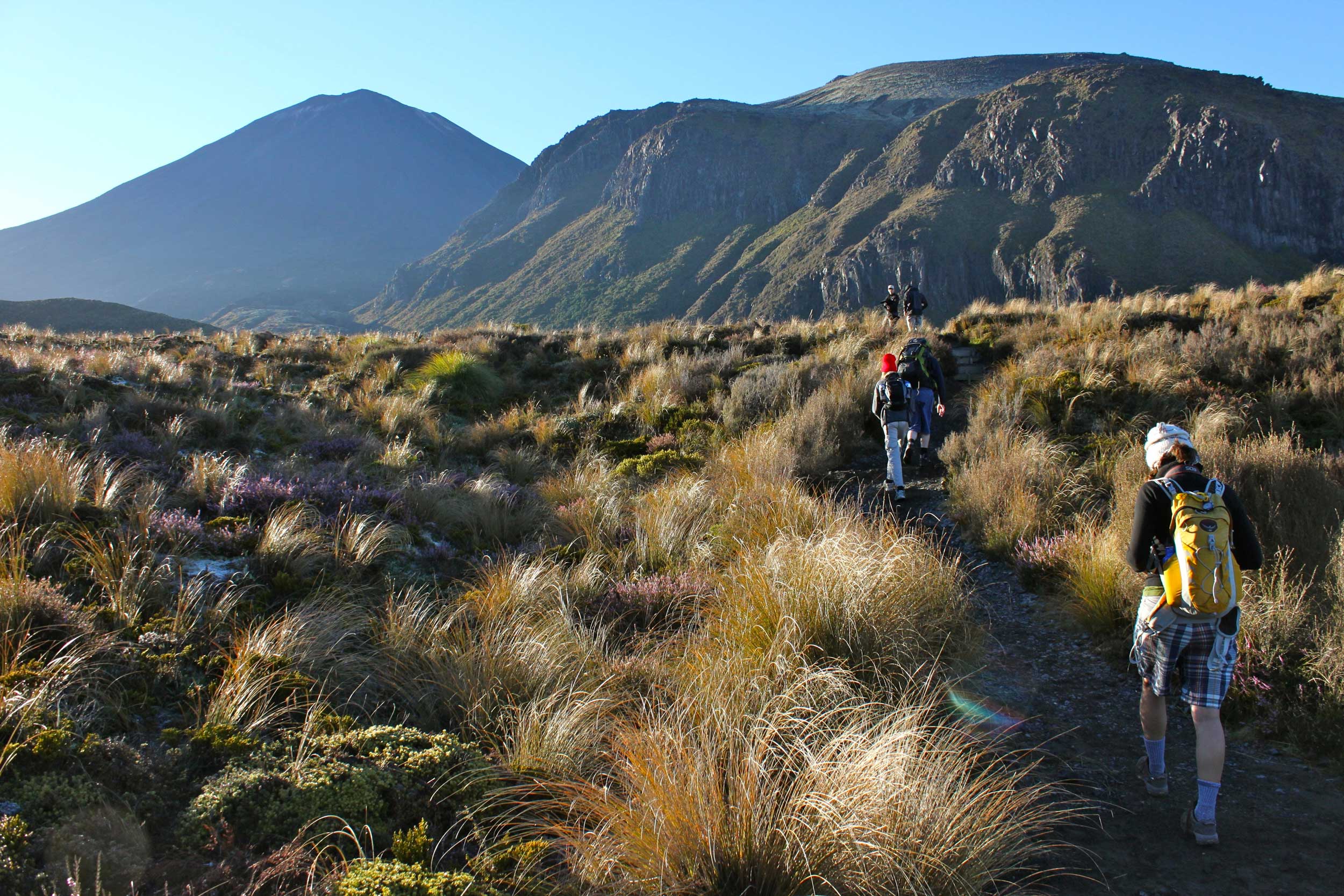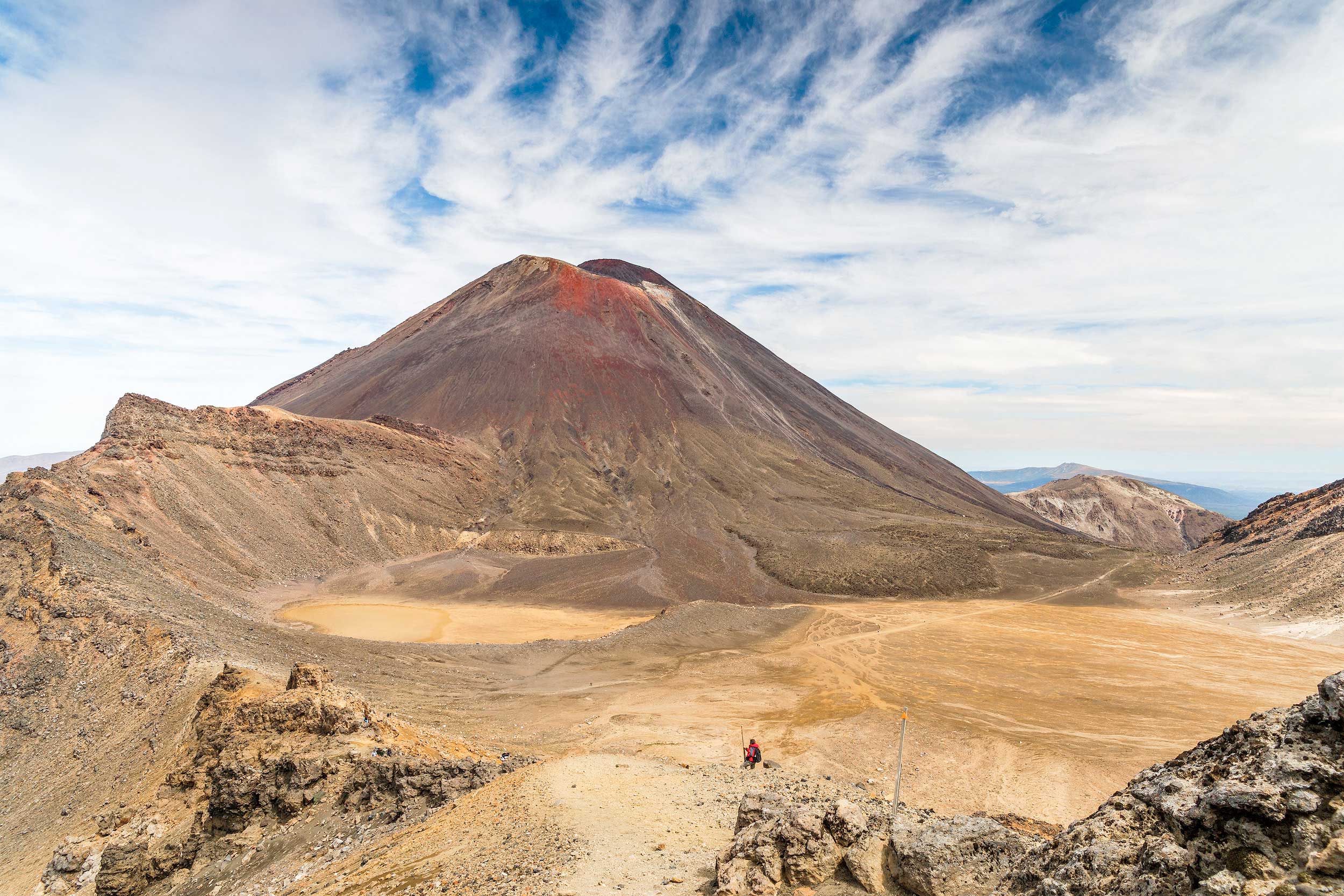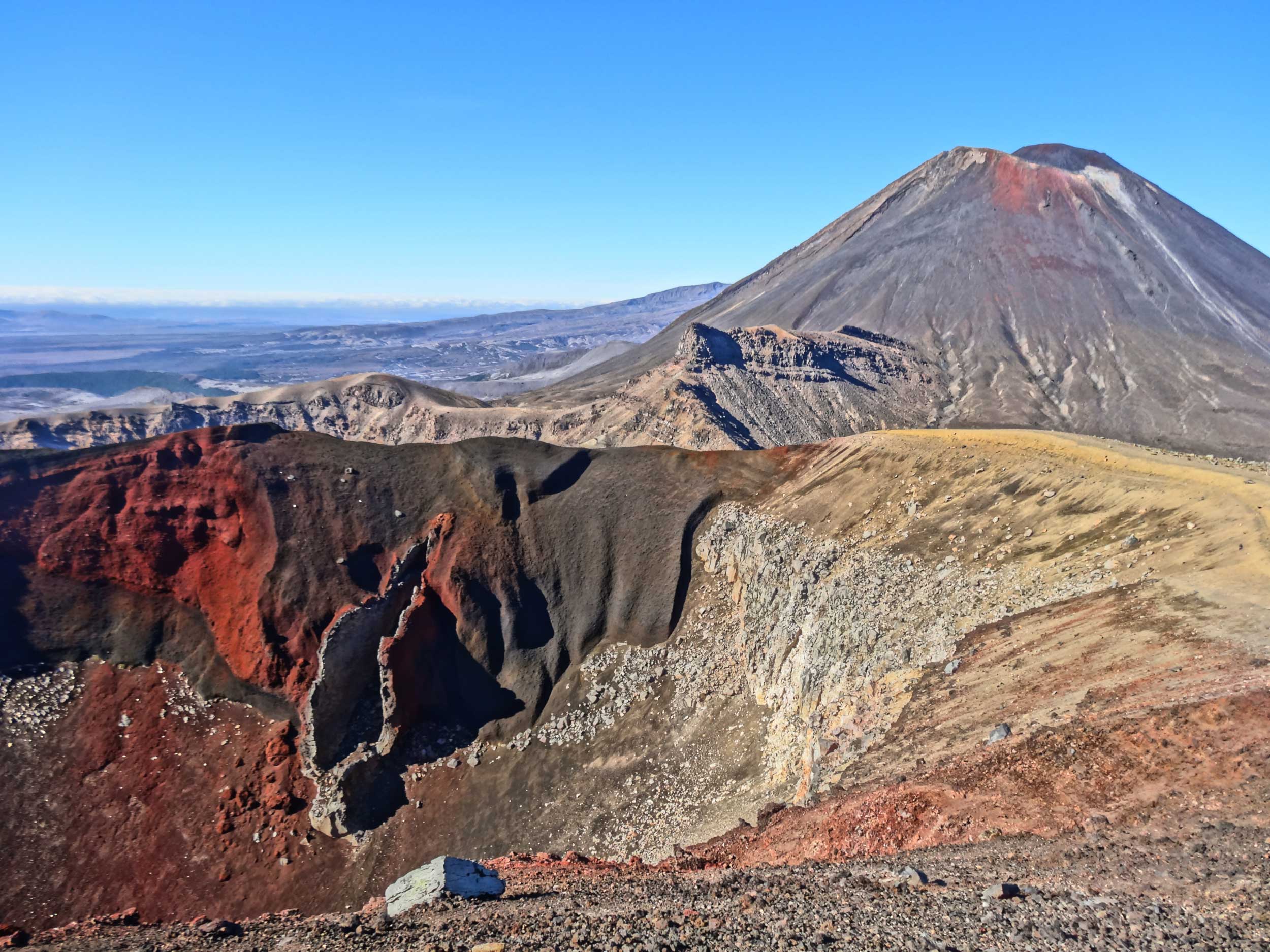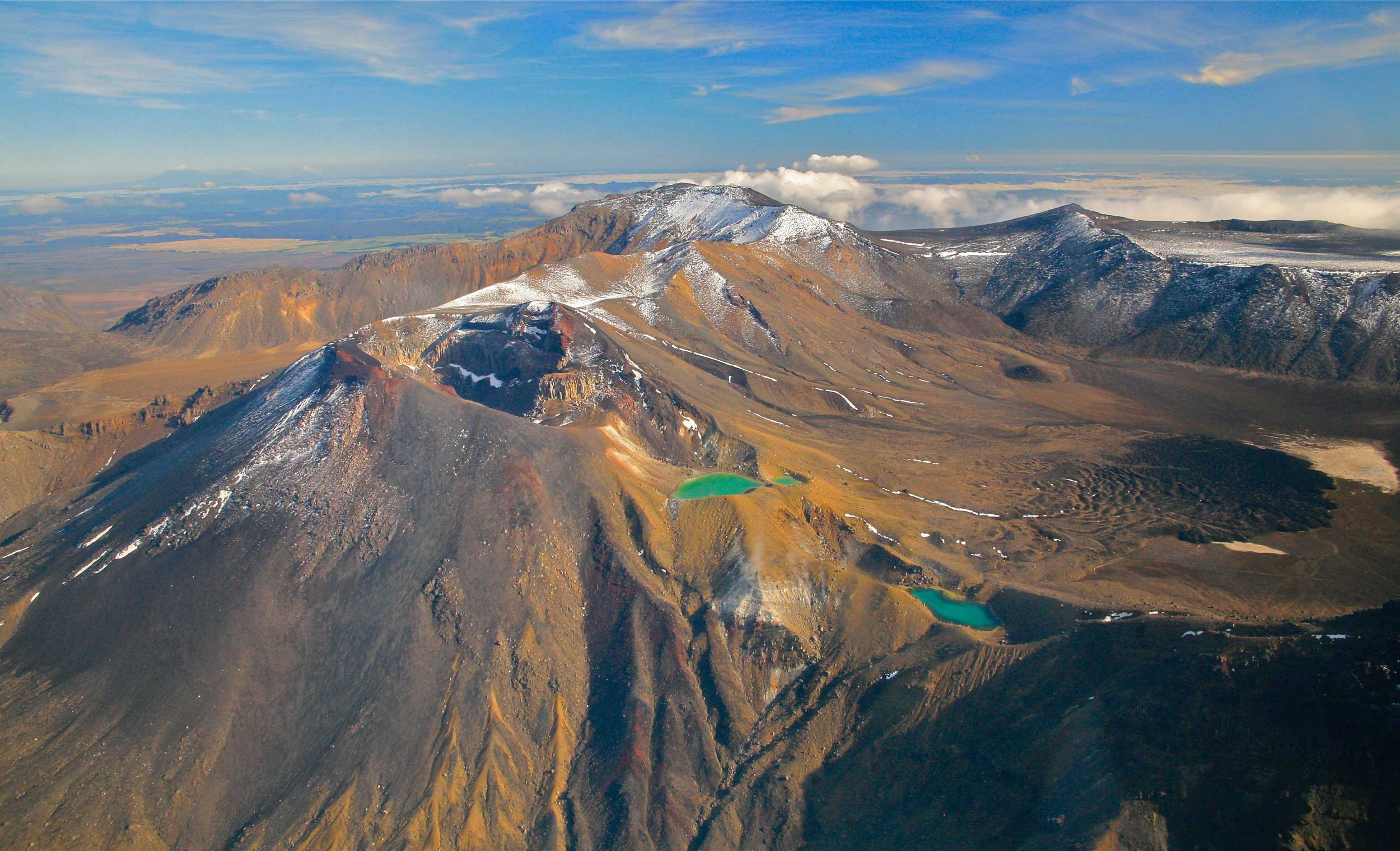New Zealand’s Greatest Day Hike: The Tongariro Alpine Crossing
A scarred and violent landscape — torn apart by an ancient love triangle, according to Māori legend — is the setting for the iconic Tongariro Alpine Crossing. The legend adds a deep spiritual dimension to this scenic 19-kilometre hike in the centre of New Zealand’s North Island.

The Trail
The Tongariro Alpine Crossing is a challenging one-day walk through raw, volcanic terrain shaped by the highly active volcanoes of Tongariro, Ngaruahoe and nearby Ruapehu. Almost the entire length of the 19-kilometre route is devoid of vegetation and is fully exposed to the weather. Upwards of 25,000 walkers complete the crossing each year, making it the most popular walk in the North Island of New Zealand. The trail can be walked from either end, but typically hikers set off from Mangatepopo car park in the west and finish at Ketetahi car park, to the north-east.
Key highlights on the hike are two steep ascents, brightly coloured rocks and lakes, steaming fumeroles and extensive views of the surrounding landscape including Lake Taupo and a distant Mount Taranaki. Hikers are encouraged to read the fascinating Māori legend of the land before they set off, to fully appreciate the experience.

Hiking The Trail
Part 1: Mangatepopo Valley to the Devil’s Staircase | 1–1.5 hours
Terrain: Generally flat with boardwalks in place to protect the fragile flora.
This is the preferred end at which to start the walk as it minimises the amount of climbing. Commercial shuttles will transport walkers to and from either end.
The start of the track has a generally flat grade with boardwalks in place, allowing for an easy start. Walkers are rewarded with a kaleidoscope of colour in both the volcanic rock and low-growing ground cover, especially the vibrant mosses. To the right, the ever-present perfect cone of Mount Ngaruahoe dominates the view all the way to the foot of the Devil’s Staircase, the first of two steep climbs.
Part 2: The Devil’s Staircase | 40 minutes–1 hour
Terrain: Steep and winding with some wooden stairs.
A cautionary sign at the bottom of the ascent requires walkers to choose whether to continue or turn back. It quickly becomes apparent that the stairs are steep, but luckily there are several blocks of small stones encased in wire netting to rest up on at about the midway point. Zig-zagging from side to side is tough on the thighs and knees, however the views from the top are worth it. On a clear day Mount Taranaki is visible, sitting in splendid isolation on the western horizon.

Part 3: Soda Springs across South Crater | 30 minutes
Terrain: Flat and smooth underfoot.
At the top of the Devil’s Staircase the terrain levels out with two side trails deviating from the main track: one leading to a nearby waterfall called Soda Springs (15 mins return) the other to the summit of Mount Ngaruahoe (3 hours return). From here, the main track crosses South Crater, a large flat area of light brown broken by isolated clumps of tussock.
It will become apparent to walkers why this area was chosen as Modor in the Lord of the Rings trilogy. There is an unsettling feeling here of tension and smouldering bitterness as if there are ancient scores to settle, the Māori legend coming to life. From a high vantage point, it’s possible to read names written on the ground by previous hikers, the letters formed by the even placement of small stones. Hikers often take a photograph at the start of the walk across South Crater as it is the perfect example of a ‘vanishing point’ illusion, with walkers diminishing in size as they walk towards the horizon.

Part 4: South Crater to Red Crater | 45 minutes–1 hour
Terrain: Steep incline with unstable small rocks and scoria underfoot.
At the end of South Crater, walkers will find a second steep climb that takes them to the highest point on the crossing, 1886 metres above sea level. The ascent is rocky in places and walkers must take care on the loose scoria. The reward at the top is, for many hikers, the highlight on the entire crossing. The views are spectacular and photographs from here define the walk: Red Crater with Mount Ngaruahoe in the background to the right; the Emerald and Blue Lakes ahead; simmering steam vents; and a side track to the summit of Mount Tongariro to the left. The track can be clearly seen descending to the Emerald lakes, across to the Blue Lake and beyond.
The colours in the Red Crater are caused by high temperature oxidation of the iron in the rock, with hues ranging from deep red to yellow. The crater is constantly active with steam vents and a strong smell of sulphur. Due to its heat it is never covered with snow in the winter.
Part 5: Red Crater to the Blue Lake | 30–45 minutes
Terrain: Mostly downhill with a small ascent out of the Central Crater.
After passing the Emerald Lakes then skirting the ridge around the Central Crater, hikers will reach the shores of the larger Blue Lake. Formed when rainwater filled an old lava vent, the lake is 16 meters deep and very acidic. The lake is tapu (sacred) and it is disrespectful to eat, drink or swim along its shore. Beyond the Blue Lake there is a view of Mount Pihanga, the comely female mountain at the centre of the Māori legend, and beyond this, Lake Taupo.

Part 6: Blue Lake to Ketetahi Shelter | 1 hour
Terrain: Downhill with open spaces and reappearing flora.
This part of the track is deemed the ‘active volcanic hazard zone’ where hikers can see the Te Maari craters up close, and also view the impact craters where flying rocks landed during eruptions. The Te Maari craters last erupted in 2012, damaging parts of the track and the Ketetahi Hut. The hut is now a simple shelter and is no longer available as overnight accommodation.
Part 7: The final leg to the Ketetahi Carpark | 2 hours
Terrain: Downhill to and through the tree line.
The final part of the trail is a leisurely descent through golden tussock to the podocarp and hardwood tree line. The appearance of bird life is a welcome contrast to the volcanic silence during the former part of the trail. To the north there is a clear view of Lake Rotoaira where — according to Māori legend — Mount Taranaki once stood, his footprint now filled with water, to form the lake.
Who This is For
The Crossing is challenging but not too difficult, providing walkers have a reasonable level of fitness. Numerous rest breaks are essential, especially after ascending the Devil’s Staircase and the ridge from South Crater to Red Crater. Keen hikers can add the ascension to Mount Ngauruhoe to their itinerary to add to the challenge.
When to Go
The summer months (December to March) are the most popular times to walk the crossing as the weather is warm and usually dry. The clear weather allows for stunning photographs to be taken from high vantage points especially down onto South Crater and the Emerald Lakes. This is also the busiest time to go, so those looking for a quieter hike should consider the cooler months of Spring (October to early December) or Autumn (April to June). Be advised that sudden rain showers are common in these shoulder months.
In winter (June to September) the crossing is a very different place. Freezing temperatures, the risk of avalanches, short daylight hours, pole markers covered in snow and ice-covered ascent routes are all potential hazards. If visiting at this time, consider using a guide or tour company that specialises in winter hikes. They will also arrange shuttles and supply any additional gear that is required.
Where to Stay
The National Park Village offers motels, backpacker hostels and lodges, while nearby, the grand and historic Chateau Tongariro on Mount Ruapehu is at the upper end of luxury. All accommodation providers are serviced by local shuttle companies offering pick up/drop off to the Tongariro Alpine Crossing. Book at reception when checking in.
ESSENTIAL INFORMATION
- The Emerald and Blue Lakes are not visible in winter; they are frozen and covered in snow.
- Drinking water is not available anywhere on the track, so take at least two litres per person. It is not safe to drink water from the streams or lakes.
- The most technical aspect of the trail is descending from Red Crater, which is steep with loose stones underfoot. Walking poles can be a great help for this part of the trail.
- During the summer, the car parks at either end of the route will fill to capacity, making it sensible to book a bus transfer instead of driving.
USEFUL LINKS
www.doc.govt.nz/tongariroalpinecrossing
